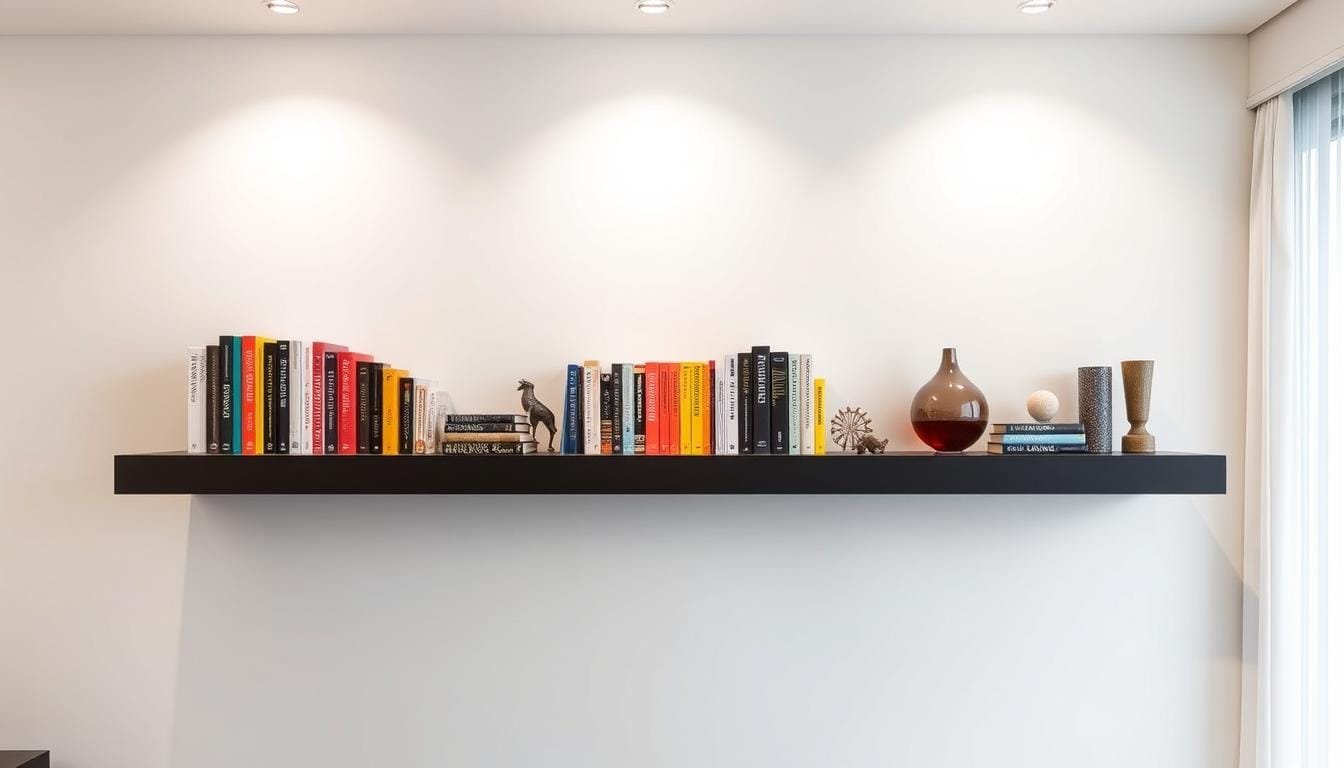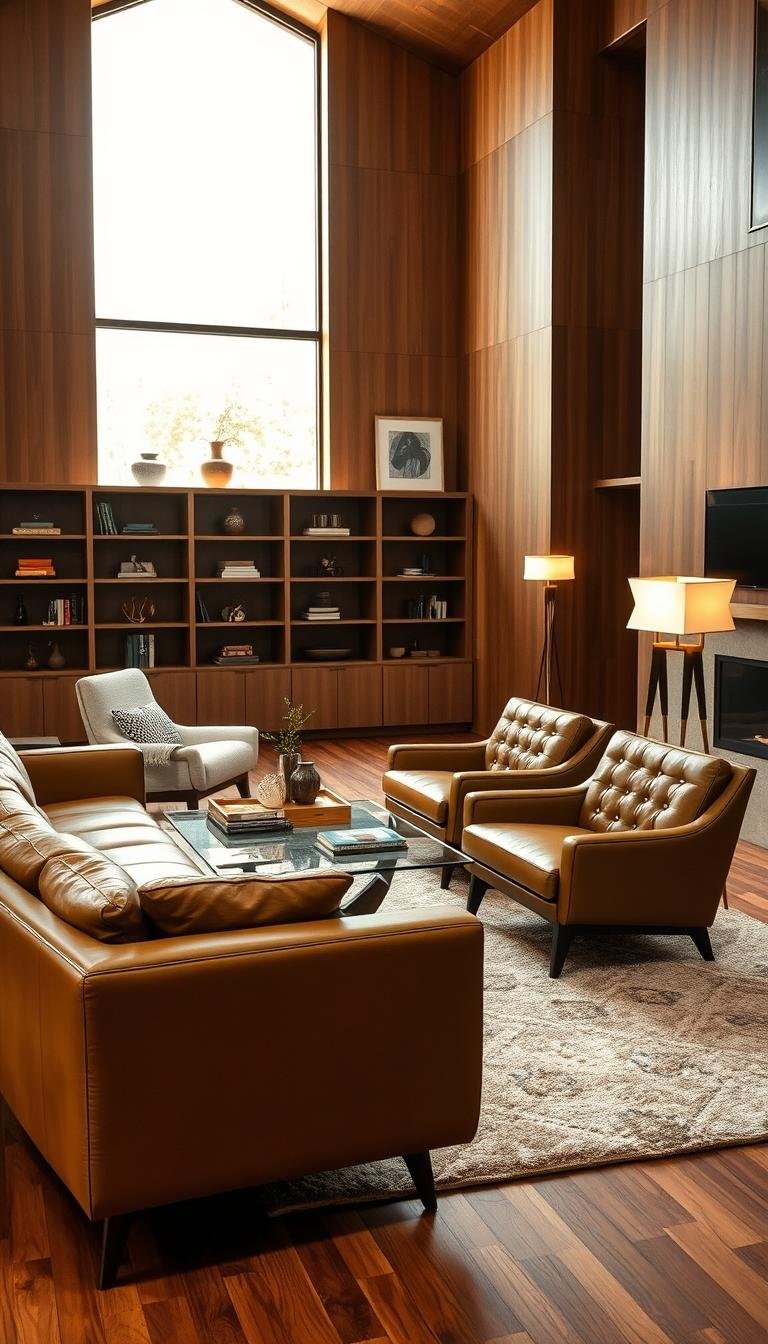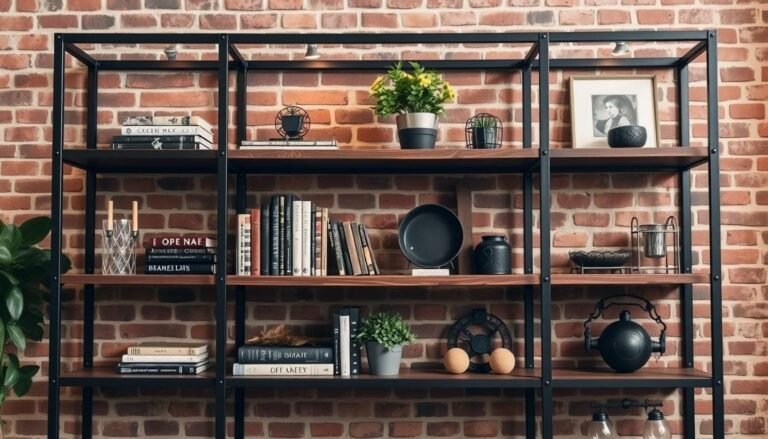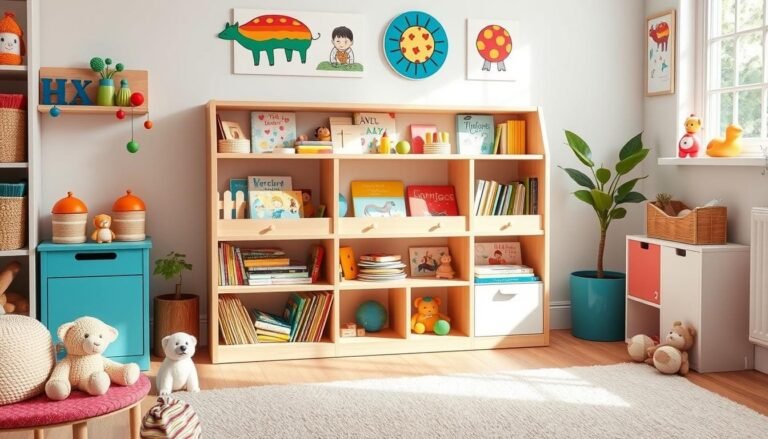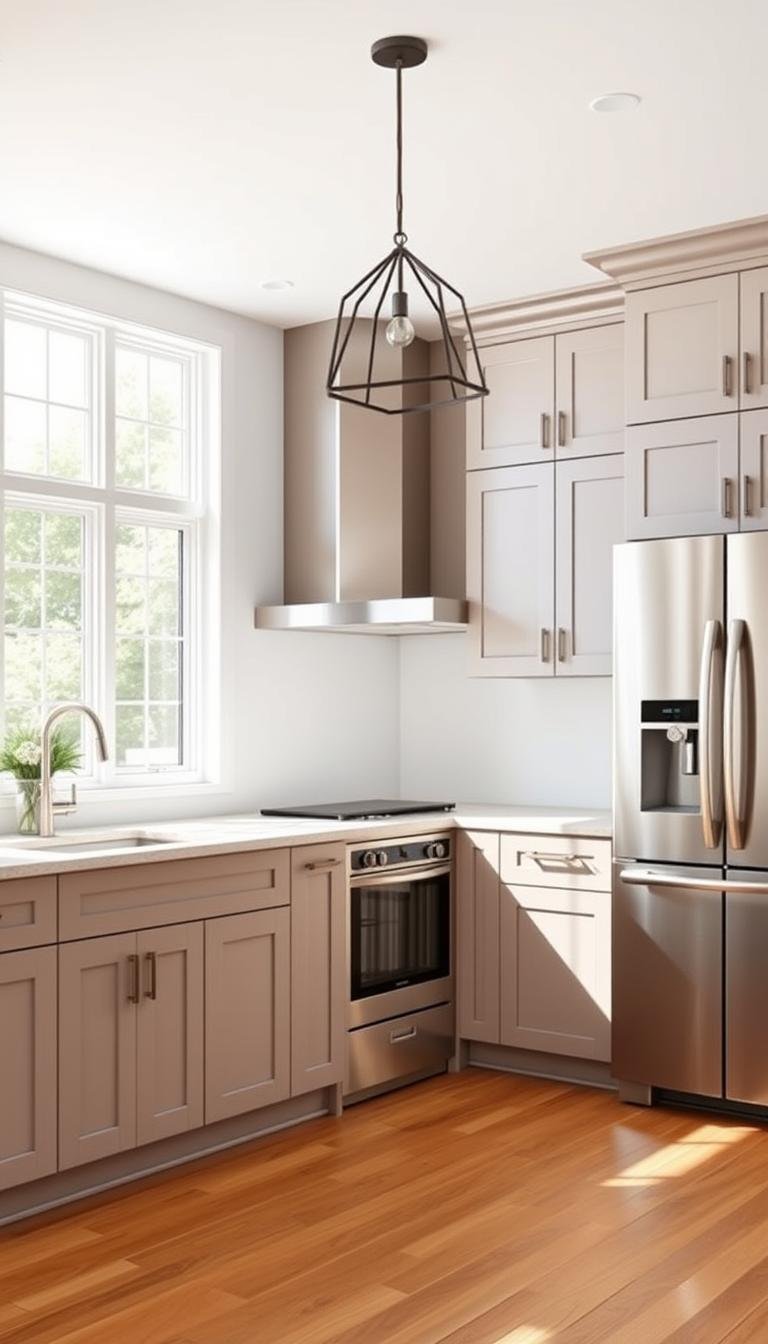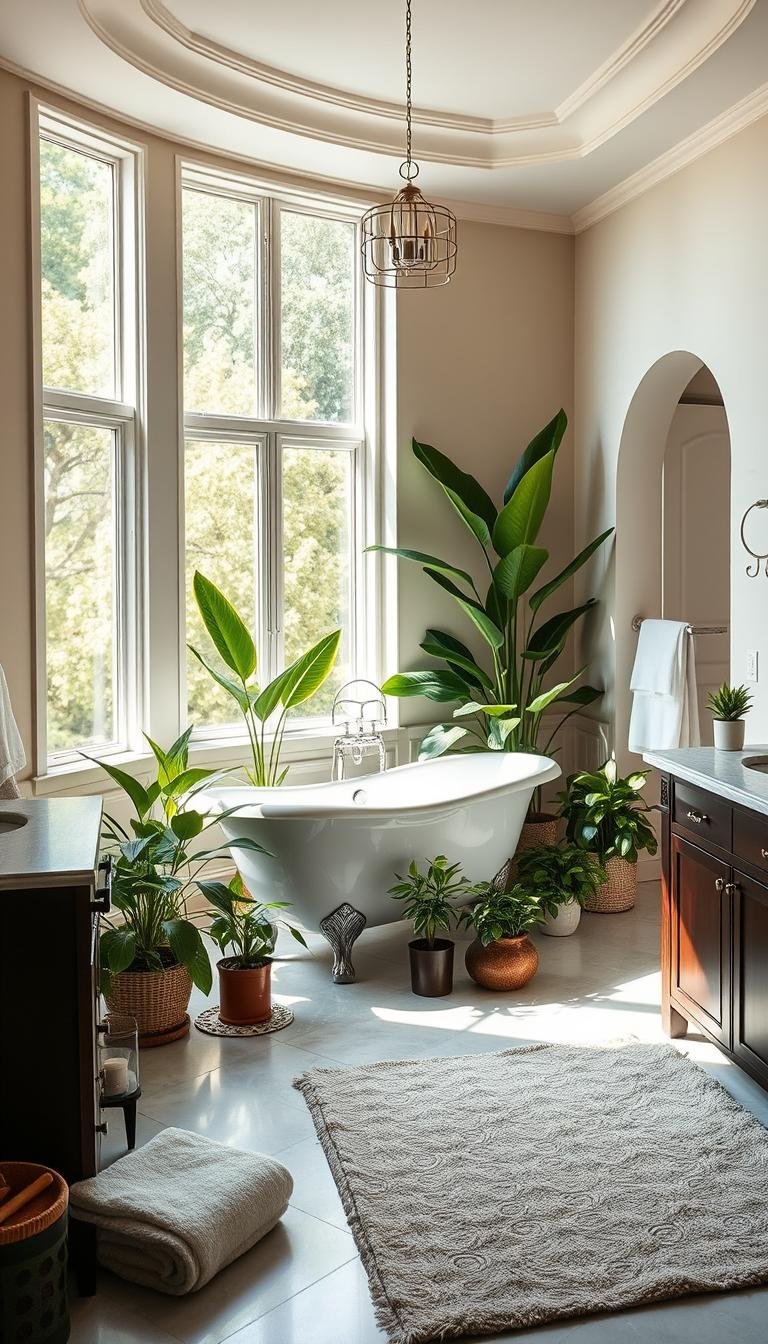This post may contain affiliate links. If you click and buy, we may earn a small commission at no extra cost to you. Learn more.
Building a modern, space-saving floating bookshelf can make any room look better. It keeps your favorite books and decorations organized and easy to find. This guide will show you how to make a stylish, space-saving bookshelf that’s perfect for any home.
Our DIY guide will tell you what materials you need and how to put it together. We’ll also give you tips on where to place it and how to decorate it. This will help you create a beautiful, functional bookshelf that adds style to your home.
Contents
- 1 What is a Floating Bookshelf?
- 2 Materials Needed for Your DIY Project
- 3 Step-by-Step Guide to Building Your Bookshelf
- 4 Tips for Choosing the Right Location
- 5 Painting and Finishing Your Bookshelf
- 6 Decorating Your Floating Bookshelf
- 7 Common Mistakes to Avoid
- 8 Maintenance and Care for Floating Bookshelves
- 9 Alternatives to Traditional Floating Bookshelves
- 10 Exploring Floating Bookshelf Styles
- 11 FAQ
- 11.1 What is a floating bookshelf?
- 11.2 What are the benefits of a floating bookshelf?
- 11.3 What materials do I need to build a floating bookshelf?
- 11.4 How do I build a floating bookshelf?
- 11.5 How do I choose the right location for my floating bookshelf?
- 11.6 How do I paint and finish my floating bookshelf?
- 11.7 How do I decorate my floating bookshelf?
- 11.8 What are some common mistakes to avoid when building a floating bookshelf?
- 11.9 How do I maintain and care for my floating bookshelf?
- 11.10 What are some alternatives to traditional floating bookshelves?
- 11.11 What styles of floating bookshelves are available?
What is a Floating Bookshelf?
A floating bookshelf is a bookshelf that looks like it’s floating on the wall. It’s perfect for modern homes because it’s sleek and simple. If you’re into DIY projects, a floating bookshelf is a great choice.
The idea behind a floating bookshelf is simple yet effective. It’s mounted on the wall, making it look like it’s floating. This adds elegance to any room. Plus, it’s a great way to add storage and style to your home.
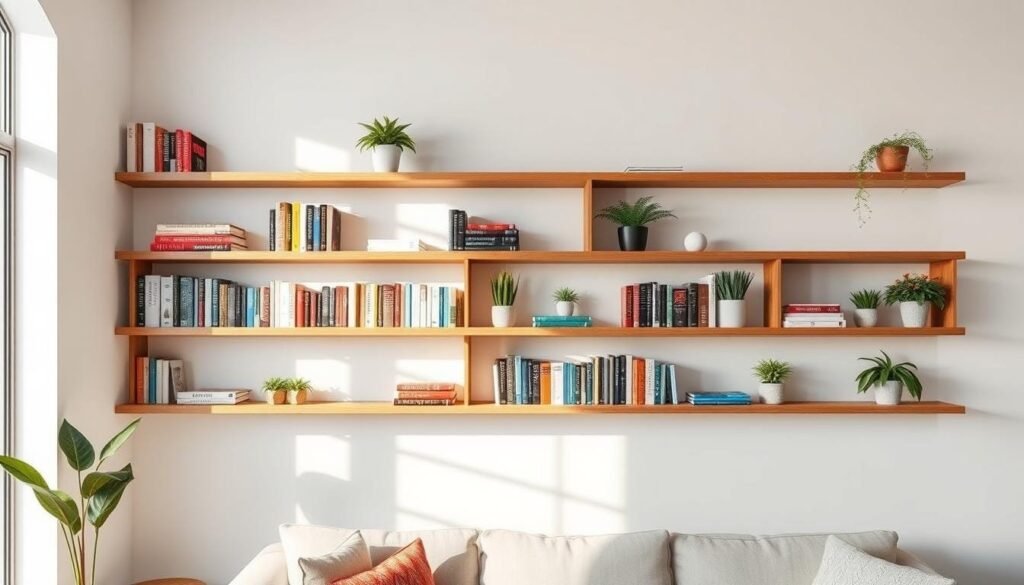
Definition and Concept
A floating bookshelf is a shelf mounted on the wall without visible supports. This design is clean and minimalist, ideal for modern homes. When making a floating bookshelf, remember to check its weight capacity and the type of wall it will be on.
Benefits of Floating Bookshelves
Using a floating bookshelf has many advantages. Some of these include:
- Increased storage space
- Improved aesthetics
- Easy installation
With a floating bookshelf, you can boost your home’s storage and style. It’s a fun DIY project that can make your home look beautiful and elegant.
Materials Needed for Your DIY Project
To start your DIY shelving unit, you need to gather all the right materials. This includes different types of wood and finishes, tools, and extra supplies. A good floating shelf tutorial will help you, but having the right stuff is key.
When picking wood, you have many options. You can choose from pine, oak, and maple. Think about the wood’s color, texture, durability, and how it resists warping. Also, pick a finish like stain, paint, or varnish to protect and beautify the wood.
Wood Types and Finishes
Here are some things to think about when picking wood and finishes for your DIY shelving unit:
- Wood type: pine, oak, maple, or other species
- Wood thickness: 1/2 inch, 3/4 inch, or 1 inch
- Finish: stain, paint, varnish, or polyurethane
Tools Required
To put together and install your floating shelf, you’ll need various tools. These include:
- Power drill and bits
- Saw or circular saw
- Sander and sandpaper
- Measuring tape and level
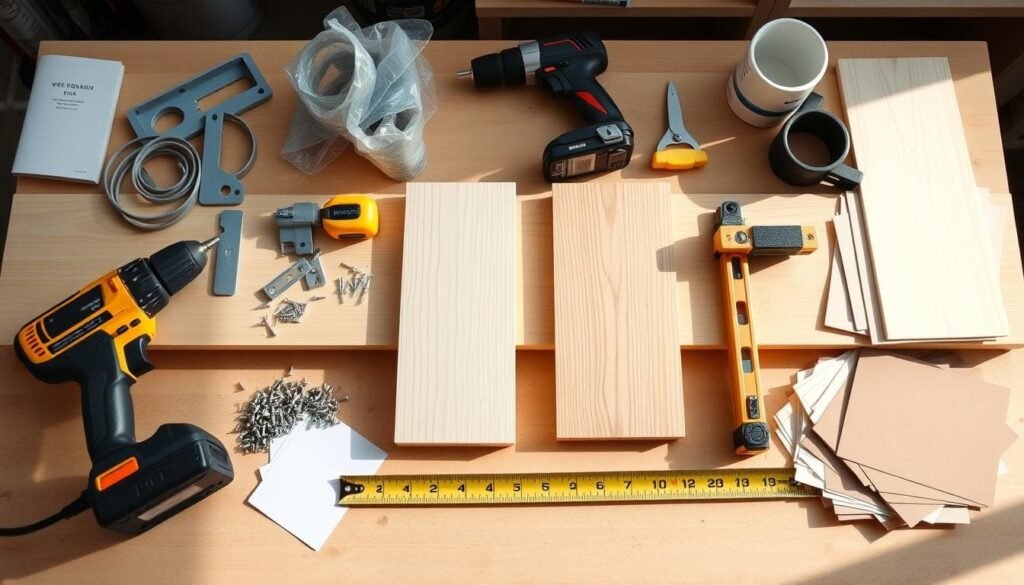
Additional Supplies
Don’t forget to get extra supplies like wall anchors, screws, and brackets. They make sure your shelf is secure and sturdy. With the right materials and tools, you’re ready to make a beautiful and useful floating shelf for your home.
Step-by-Step Guide to Building Your Bookshelf
Building an easy floating bookshelf is a fun DIY project. You’ll need the right materials and patience. Soon, you’ll have a beautiful DIY shelving unit for your favorite books and decorations.
To start, prepare the wood for your bookshelf. Cut it to size and sand it for a smooth finish. Choose wood and finishes that match your home’s style, from modern to rustic.
Preparing the Wood
After preparing the wood, assemble the shelf. Attach the sides and bottom with screws or nails. Make sure it’s level and secure before moving on.
Assembling the Shelf
Now, install the shelf on the wall with brackets or screws. This step is key to ensure the shelf holds your items securely. Use a level to keep it straight and even.
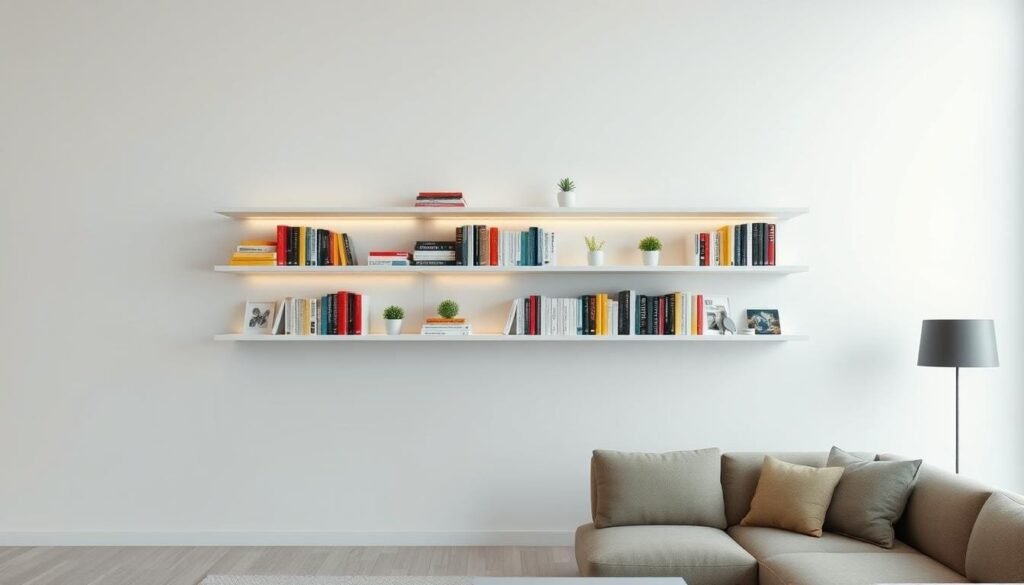
Installing the Shelf on the Wall
By following these steps, you’ll have a beautiful floating bookshelf. Remember to be patient and pay attention to detail. Building a DIY shelving unit takes time and effort.
Tips for Choosing the Right Location
Choosing the right spot for your floating bookshelf is key. A well-placed space-saving bookshelves can greatly enhance your room’s look and function. To get your modern bookshelf DIY just right, keep these tips in mind.
Start by checking the wall space for your bookshelf. Think about the shelf’s size and the area around it. Your bookshelf should fit well in the room and not take over. Also, pick a spot that matches your room’s style and design.
Assessing Wall Space
Next, think about the room’s lighting. If you’ll have books or decorations on your shelf, pick a spot with good light. Natural light is best, but a lamp or sconce can work if that’s not possible.
Lighting Considerations
Lastly, think about how easy it is to access and use your bookshelf. It should be stylish and convenient. By picking the right spot, you’ll have a beautiful and useful space-saving bookshelves that goes well with your modern bookshelf DIY project.
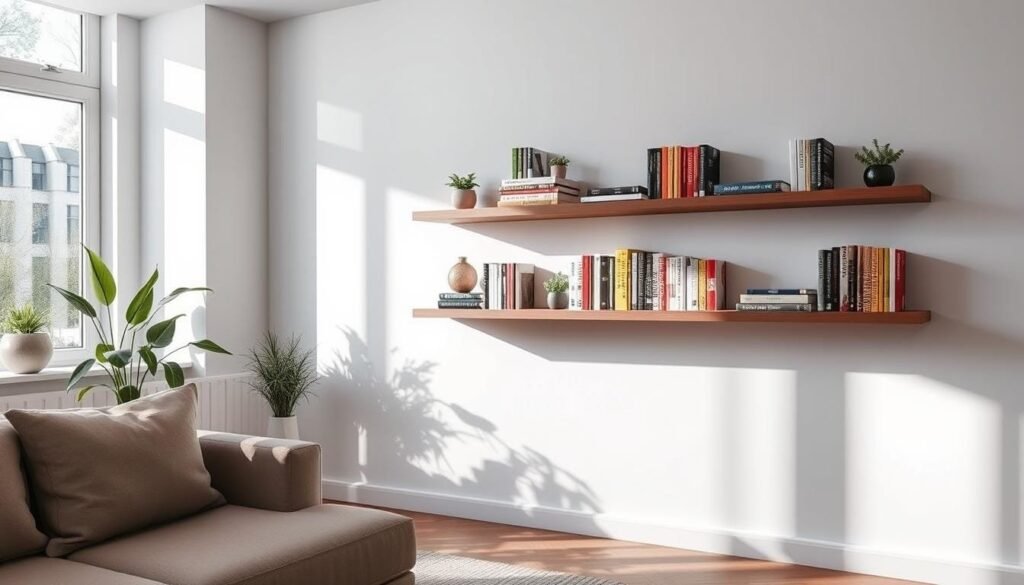
Accessibility and Style
Other things to think about include the wall’s color and texture, and the furniture and decor around it. By carefully considering these, you can make a bookshelf that looks great and works well in your room.
Painting and Finishing Your Bookshelf
To add a personal touch to your wall-mounted bookshelf, consider the painting and finishing process. This step can enhance the overall appearance of your modern bookshelf DIY project. It also protects the wood from damage. When choosing the right paint, think about the color scheme and style you want to achieve.
For a modern look, opt for a bold and bright color. A rustic theme may call for a more muted tone.
Here are some tips to keep in mind when painting and finishing your bookshelf:
- Prepare the surface by sanding it to create a smooth finish
- Apply a primer to ensure better paint adhesion and durability
- Use a high-quality paint that is suitable for the type of wood you are using
Once you have applied the paint, allow it to dry completely. Then, seal the wood with a clear coat. This will help protect the finish and make it easier to clean. By following these steps, you can achieve a professional-looking finish for your wall-mounted bookshelf.
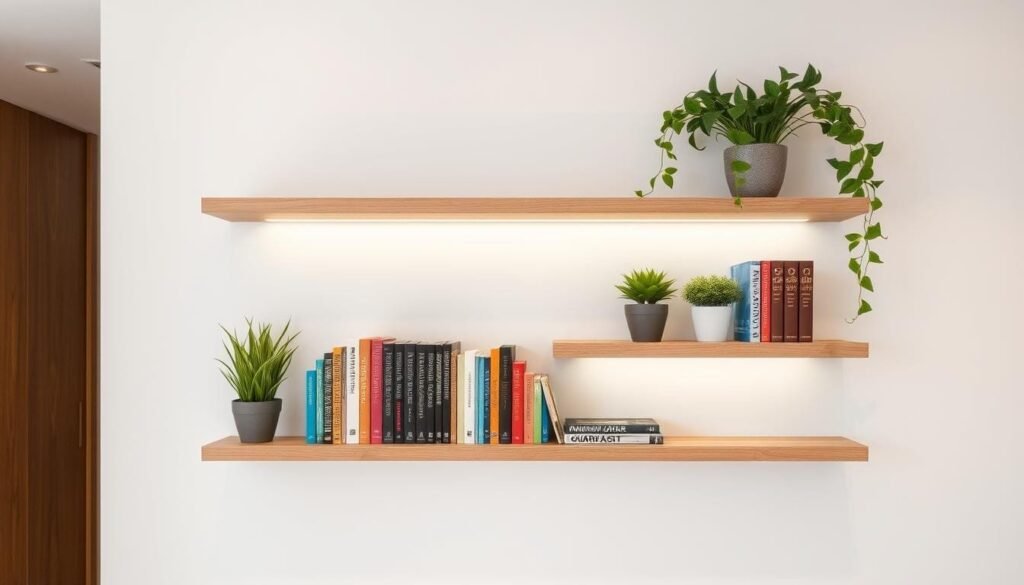
Remember to work in a well-ventilated area. Use a drop cloth to protect your floor from any spills or stains. With a little patience and creativity, you can create a beautiful and functional wall-mounted bookshelf. It will reflect your personal style and complement your home decor.
Decorating Your Floating Bookshelf
Decorating your floating bookshelf is a fun step to make it truly unique. An easy floating bookshelf lets you add a personal touch without losing style or function.
Start by thinking about the look you want. Consider the colors, furniture style, and the mood you aim for. Choose books and decor that match in color, texture, and size for a unified look.
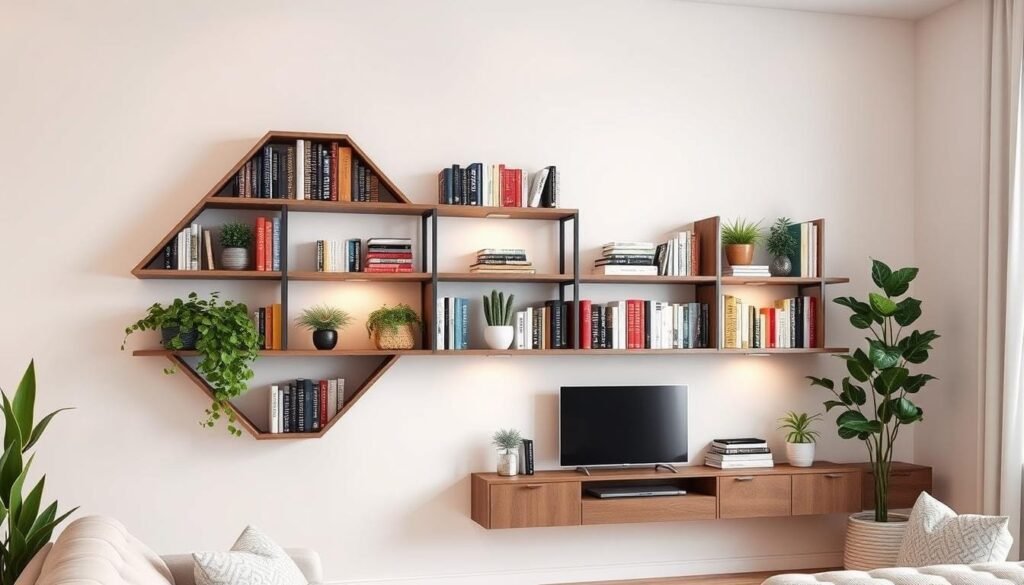
- Balance heavy books with lighter decor items to maintain visual harmony.
- Play with textures by mixing smooth, rough, and soft elements.
- Leave some space between items to avoid clutter and create a sense of breathability.
Follow these tips and try out different setups. You can turn your easy floating bookshelf into a beautiful centerpiece. It will show off your personal style and flair.
Common Mistakes to Avoid
Building a DIY shelving unit, like a floating shelf, requires careful planning. Knowing common mistakes can help you avoid them. This way, you can ensure your project is a success and safe to install.
First, think about how you’ll distribute the weight of your DIY shelving unit. If you don’t, the shelf might collapse. This could damage your things and even hurt someone. Always check the weight limits given by the manufacturer. Also, make sure to secure the shelf to the wall properly.
Another mistake to avoid is not using wall studs. If you don’t anchor your shelf to the studs, it won’t be stable. Take the time to properly find the studs. Then, use the right hardware to hold your shelf in place.
Common Mistakes to Watch Out For:
- Improper weight distribution
- Neglecting wall studs
- Skipping safety precautions
Knowing these common mistakes and taking precautions can make your DIY shelving unit installation a success. Always follow a good floating shelf tutorial. And don’t rush. This way, you can avoid expensive mistakes.
Maintenance and Care for Floating Bookshelves
To keep your wall-mounted bookshelf looking great, regular care is key. It’s not just about dusting the books and decorations. A well-kept floating bookshelf adds beauty to any room, saving space for book lovers.
For a space-saving bookshelf, cleaning and dusting are musts. Use a soft cloth to clean the shelf and its contents. Make sure to focus on any detailed carvings. Stay away from harsh chemicals or abrasive cleaners to avoid damage.
Cleaning and Dusting Tips
- Dust the shelf and its contents regularly to prevent dust buildup
- Use a soft, dry cloth to wipe down the shelf and its contents
- Avoid using harsh chemicals or abrasive cleaners
Regularly check the shelf’s stability too. Inspect the mounting hardware to ensure it’s secure and the shelf is level. This prevents the shelf from tipping or falling, which can damage the shelf, wall, and items on it. By following these tips, your wall-mounted bookshelf will stay in top shape, saving space for years.
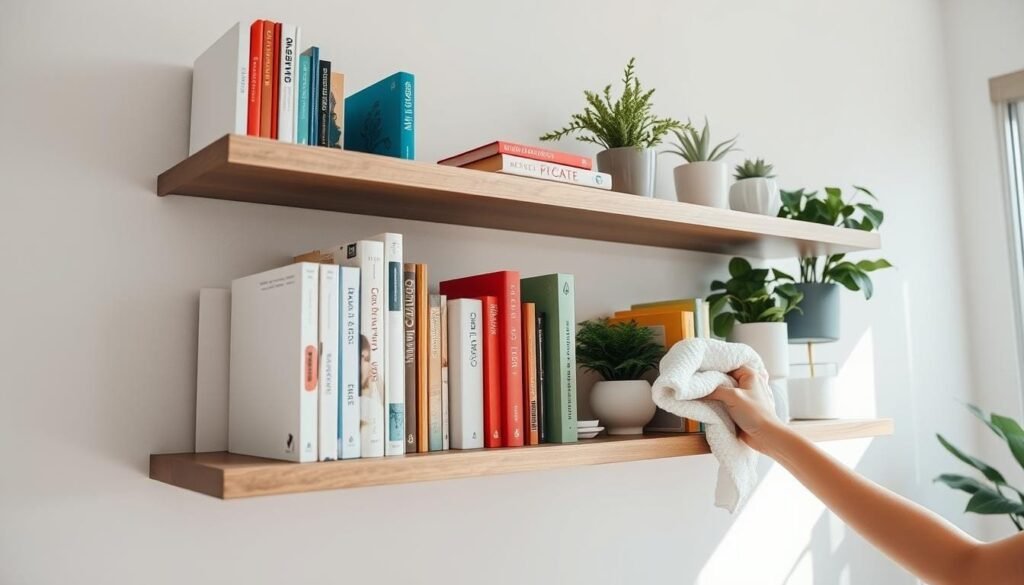
Alternatives to Traditional Floating Bookshelves
There are many ways to make a modern bookshelf DIY, not just traditional floating ones. These options can make your space unique and offer lots of storage for books and decorations.
Bracketed shelving is an easy choice for a floating bookshelf. It uses visible brackets for support. This style adds an industrial vibe to your room.
Bracketed Shelving
Bracketed shelving is a favorite for many. It’s simple to set up and can be tailored to your needs.
Glass and Acrylic Options
For a sleek look, try glass or acrylic shelves. They’re modern and elegant, adding class to your area.
Corner Floating Shelves
Corner floating shelves are perfect for using every inch of your space. They fit into corners, making a useful and stylish storage spot.
Exploring these alternatives to traditional floating bookshelves can lead to a unique and practical storage solution. It meets your needs and brings style to your space.
Exploring Floating Bookshelf Styles
Starting your DIY floating bookshelf project opens up a world of styles. You can choose from sleek, modern designs to rustic and industrial looks. Each style can match your room’s decor perfectly. Plus, you can add your personal touch to make it fit right in.
Modern Minimalist Designs
For a modern, clean look, go for a floating shelf with simple lines. These designs often use wooden or metal shelves. They make your space feel lighter and are great for small areas or minimalist rooms.
Rustic and Industrial Looks
Love a weathered, industrial look? Check out floating bookshelves made from reclaimed wood or metal. These styles bring warmth and character to your space. They pair well with exposed brick, concrete, or vintage items.
Customizable Options
Want a truly unique shelf? Look for designs you can customize. You can change the size, shape, and finish to match your style. With some creativity, you can make a floating bookshelf that’s all your own.
FAQ
What is a floating bookshelf?
A floating bookshelf is mounted on the wall. It looks like it’s floating. This design is great for modern homes, adding a sleek look.
What are the benefits of a floating bookshelf?
Floating bookshelves offer more storage and a clean look. They save space, making them perfect for small rooms.
What materials do I need to build a floating bookshelf?
You’ll need wood, tools, and more for a floating bookshelf. The materials depend on your design. You’ll also need a saw, drill, and screws.
How do I build a floating bookshelf?
Building a floating bookshelf is easy with our guide. It covers preparing wood, assembling, and wall installation. It’s perfect for DIY beginners.
How do I choose the right location for my floating bookshelf?
Pick a spot based on wall space, lighting, and style. Make sure it fits your room’s design and storage needs.
How do I paint and finish my floating bookshelf?
Painting and finishing protect the wood and enhance its look. Our guide offers tips on paint choice, application, and sealing. We’ll help you achieve a professional finish.
How do I decorate my floating bookshelf?
Decorating adds personality to your room. Our tips include choosing decor, creating a cohesive look, and seasonal styling. We’ll help balance function and style.
What are some common mistakes to avoid when building a floating bookshelf?
Avoid weight issues, neglecting studs, and safety mistakes. Our tips will help you build successfully.
How do I maintain and care for my floating bookshelf?
Proper care keeps your bookshelf stable and looking good. Our tips include cleaning, dusting, and regular checks. We’ll also help with common problems.
What are some alternatives to traditional floating bookshelves?
Consider bracketed shelving, glass, and acrylic options, and corner shelves. We’ll discuss their benefits and drawbacks to help you choose.
What styles of floating bookshelves are available?
Styles range from modern to rustic and industrial. We’ll explore these and help you pick a design that fits your room and style.
To bring you cozy inspiration more efficiently, we sometimes use AI to assist in content creation — but every word and idea is carefully shaped by our team. See our AI Disclosure for more info.

